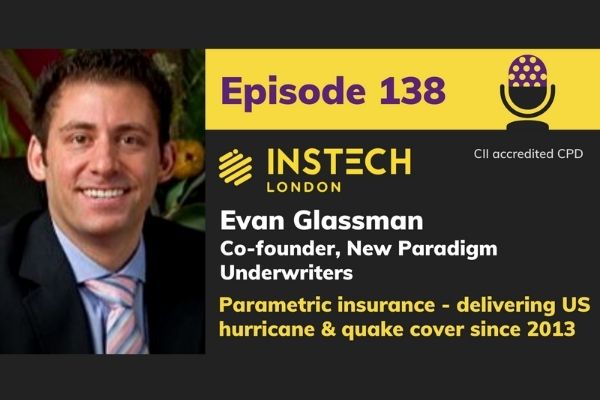Insurance policies may leave businesses exposed to uninsured economic loss in the event of a hurricane or earthquake, because of excess, deductibles and exclusions.
New Paradigm Underwriters offers parametric insurance products which use the wind speed of hurricanes and shake intensity of earthquakes to determine payouts to their clients in North America.
Co-founder Evan Glassman joins Matthew on Podcast 138 to discuss New Paradigm’s technology and how to build parametric products.
Talking points include:
- Measuring hurricane-force wind speeds
- Basis risk in traditional and parametric insurance
- The parametric insurance community
- The benefits of parametric products to protection sellers
- Educating brokers and buyers about parametric
If you like what you’re hearing, please leave us a review on whichever platform you use, or contact Matthew Grant on LinkedIn.
Sign up to our newsletter for a fresh view on the world every Wednesday morning.
Continuing Professional Development – Learning Objectives
InsTech London is accredited by The Chartered Insurance Institute (CII). By listening to an InsTech London podcast, or reading the accompanying transcript, you can claim up to 0.5 CPD hours towards the CII member CPD scheme.
- Claim 0.5 hours for listening to Episode 138 of the InsTech London Podcast
Parametric insurance – delivering US hurricane & quake cover since 2013 – Episode 138 highlights
Matthew: How would you describe parametric insurance?
Evan: Parametric insurance comes from the word parameter. It is insurance that is triggered by independent event parameters. New Paradigm focuses on natural catastrophes: hurricanes and earthquakes.
Matthew: Why do people need to have parametric insurance for hurricanes?
Evan: Hurricane insurance generally attaches significantly in excess of the most likely losses.
One part of the problem is deductibles, which could be from 2% to 10% or more of the total value insured. The other part is the exposures to economic losses that are not insured and do not count towards the accumulation of the deductible liability. So the economic losses can be significantly broader than what’s traditionally insured or insurable.
Matthew: What gave you the motivation to start the business in 2013?
Evan: I was a retail insurance agent in South Florida. My client base was resort hotels and high-rise condominiums, and the products that the insurance industry was providing were not fully addressing what would happen to my clients when a hurricane comes.
I researched the problem and reached out to RMS, when I found technology to measure hurricane-force winds. I had them produce what is called a hazard analysis. Then I approached my business partner Brad Meier with the idea to form New Paradigm in early 2013. Brad had founded and built from scratch what is now the largest homeowners’ insurance company in Florida.
Matthew: I remember at that time a challenge for hurricane parametric triggers was that traditional wind speed recorders would fail in catastrophic winds. Was that a challenge you faced designing the structures?
Evan: For parametric, the trigger design is the difference between a product working or not working. We need to have as robust a triggering methodology as possible.
The technology, called hurricane-hardened anemometers, came about following hurricanes in Florida in 2004 and 2005. It was recognised then that there was a lack of data on the wind speeds that hurricanes produce overland. The anemometers at airports or TV stations were not designed to operate in those extreme conditions and would often fail.
So RMS and a Bermudian reinsurer collaborated with a meteorological data company called WeatherFlow to create this technology to record the most extreme hurricane-force winds. This technology has been around now for over a decade.
Matthew: Back then, there were parametric triggers for large value catastrophe bonds or ILS (Insurance Linked Securities) markets. Are your clients different?
Evan: A large portion of our business is insurance companies, reinsurance companies and ILS investors. But we also offer small limit, small premium policies. We’ve standardised it and built it to scale.
Matthew: How do the anemometers work?
Evan: Most of them are on steel-reinforced concrete poles, weighing about 8,000 pounds. To install them requires three trucks. One to transport the pole, a second truck with a large drill—the type used to plant the pilings of high rise buildings—and a crane to set the pole into the ground.
They are generally ten metres high, the Saffir–Simpson meteorological observation height. The instrument is rated up to 224 miles per hour which, if it existed, would be a category seven hurricane. It is solar-powered with a 10-day battery backup. The data is communicated up through the cellular network and securely captured on a flash drive.
Data transparency is the central tenet of New Paradigm’s parametric contracts. Both the buyer and seller of protection can log into the same website during the same storm and know the wind speeds and the recovery levels almost in real-time.
Matthew: How many have you installed on the US east coast?
Evan: We are approaching 100 in the United States, including 41 in Florida. We have five in the Yucatán Peninsula in Mexico, and we are building up in the Caribbean and other areas as needed.
The network was initially sited with input from RMS to correlate with coastal insured values as well as the stochastic events that could potentially impact data collection. We have expanded the network in areas where there was demand and insufficient coverage.
Matthew: Has it been a challenge to find brokers and agents who understand and are willing to sell parametric products?
Evan: It was a challenge to get brokers even to pay attention before 2017. After that, we noticed a significant change in interest following hurricanes Harvey, Irma and Maria. The limitations of traditional insurance, and the claims process which can frustrate policyholders, led to an increase in demand, which has continued to grow since.
Humans have a recency bias and an optimism bias. If something has not happened in a while, we assume it will not happen. So our conversations with buyers and brokers in areas recently impacted by a large hurricane or earthquake are very different to those we have in areas not impacted by that in recent memory.
Matthew: How do you price?
Evan: The models have two inputs. First is the event set, which is the hazard probability. The second input is about how the portfolio of risk will perform for different events, which produces the damageability output. With parametric, we don’t care about the damageability. We price based upon hazard frequency and hazard severity.
Matthew: Different states have different views on parametric insurance. How have you solved that regulatory problem?
Evan: We operate as a non-admitted product. It is insurance, so the insured needs to have economic loss when the parameters trigger it. They need to attest to that loss by signing a proof of loss.
Matthew: Who is providing your capacity?
Evan: It is a growing panel of both domestic, Bermudian and European insurance and reinsurance capacity. ILS investors are also active
Matthew: Can you describe an example of the claims experience for the policyholder?
Evan: One of our insurance company clients last year had a recovery in a matter of days following the impact of Hurricane Sally. We had a financial institution policyholder in Puerto Rico during Hurricane Maria, and they were paid in full thirteen days after landfall. There was no electricity in Puerto Rico at the time, we had to wire money to their Florida office.
When the event happens, the triggers and contracts work as designed and the insured knows almost in real-time what is coming and how quickly. It is an awful experience for the person or company suffering the loss, but an opportunity to provide better solutions. The product working correctly for policyholders is our best marketing.
Matthew: Is basis risk a barrier in selling the product, or in claims payment?
Evan: There is basis risk in traditional insurance. It is the difference between the loss and the payout. Basis risk in traditional insurance is everything not covered in the contract: deductibles, uninsured exposures and the claims process, which could take a year or two or more to settle.
Basis risk does exist in parametric insurance as well. It is if the policy holder has a loss without payout being triggered or a greater than anticipated loss in a weaker event.
We have to design the correct product with the appropriate triggers for the insured. The levers that impact pricing are where the cover attaches and where it exhausts. So we discuss with potential buyers and their advisors how to get the right product that will be responsive to the needs of the purchaser.
Matthew: You’re now offering an earthquake insurance product called Shake and Pay. What triggers are you using for that?
Evan: Unlike hurricane, with earthquake, there’s more data available. We use USGS (US Geological Survey) and we use the shake intensity in the region. There is more of a correlation between economic loss and shaking than magnitude.
Matthew: What is the smallest transaction you do?
Evan: We do more with businesses, but we also insure homeowners.
Matthew: What is your view on non-hazard-related parametrics?
Evan: The central tenets for parametric are robust data and the ability to come up with probabilities of certain events occurring. That’s how to price things and that’s all that is required. If it can be independently measured and there is enough data, it can be done.
Cyber is a challenging one. While a hurricane is not going to impact the entire US coastline but a small area or region, a big enough cyber attack could do what Covid did and take down everything at the same time.
Matthew: Part of the challenge is people who don’t understand parametric. Did you see that challenge in educating not just brokers, but buyers and those further removed from the insurance buying process?
Evan: We decided a year ago that it was time for a conference dedicated solely to parametric. So we were able to curate content, we had speakers, people in the industry representing brokers, reinsurers and modelling companies, and we had a panel on the buyer’s perspective. Because it was done virtually, we were able to open it up to a broad audience. This year we are going to explore a hybrid approach where some people travel to the conference.
Matthew: Is there anything we haven’t covered you would like to talk about?
Evan: We have been focusing a lot on the benefits to the policyholder for offering risk transfer for things that are not covered by their traditional insurance and giving them a rapid infusion of liquidity. The macroeconomic term for that is the global natural disaster protection gap.
The insurance and reinsurance industry covers about a third of the total economic losses for each disaster. America is one of the most heavily insurance-penetrated countries in the world.
Superstorm Sandy impacted the New York area several years ago. Total insured losses were $20 to $23 billion, total economic losses were more than $70 billion.
We focus on the protection buyers, but there are also benefits to the protection sellers. They know up front, and then almost in real-time, what their worst losses are. And we are expanding the pool of what is insurable, bringing more risk and opportunity to deploy capital. With parametric, the risk sellers are not going to get surprises such as adverse loss developments from four years ago.
Matthew: How can people get to know more about you?
Evan: Ring us and visit our website. We have a growing group of brokers, producers and advisors familiar with our products and able to answer questions. We have extensive trading relationships with most of the large global insurance brokers. In the US we have many direct retail relationships. We also have robust wholesale relationships with some of the leading wholesalers.






